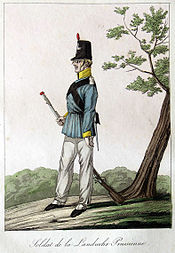Landwehr
You can helpexpand this article with text translated fromthe corresponding articlein German.Click [show] for important translation instructions.
|
Landwehr,orLandeswehr,is aGerman languageterm used in referring to certain nationalarmies,ormilitiasfound in nineteenth- and early twentieth-century Europe. In different context it refers to large-scale, low-strength fortifications. In German, the word means "defence of the country"; but the term as applied to an insurrectional militia is very ancient, andlantveriare mentioned inBaluzii Capitularia,as quoted inHenry Hallam'sMiddle Ages,i. 262, 10th edition.[1]
Austria-Hungary[edit]
AustrianLandwehr[edit]
TheAustrianLandwehrwas one of three components that made up theground forcesof theAustro-Hungarian Empirebetween 1868 and 1918, and it was composed of recruits from theCisleithanianparts of the empire. Intended as a national defence force alongside theRoyal HungarianLandwehr(orHonvéd), theLandwehrwas officially established by order of EmperorFranz Joseph Ion 5 December 1868.[2]Yet while the Hungarian force was generously supported early on by the parliament in Budapest, legislators in Vienna generally failed to advance the cause of theLandwehr,leaving it by the 1870s as a skeletal force with only the appearance of parity.[3]In 1887,Archduke Albertwrote thatLandwehrunits were not ready, in terms of training or discipline, for use in the first two weeks of a war.[4]Yet the 1880s saw an expansion in the force's numbers, as the high command was unable to obtain increases in manpower for the jointImperial and Royal Armyand sought to increase overall numbers through theLandwehr.Additionally, Austrian fears of the development of theHonvédcaused the AustrianReichsratto vote to increase theLandwehr'sstrength to 135,000.[4]These nationalist interests led to a gradual strengthening and improvement of the force, so that by the start of theFirst World War,Landwehrunits were considered equal to the units of the joint army in readiness and equipment.[5]Additionally, inTyrolandCarinthia,three units of theLandwehrwere specially trained and equipped formountain warfare.[6]
The AustrianLandwehrand other components of the Austro-Hungarian Army were all full-time standing armies.
Hungarian Landwehr[edit]
TheRoyal HungarianLandwehr(German:königlich ungarische Landwehr,Hungarian:Magyar Királyi Honvédség,colloquially called theHonvéd) orRoyal HungarianHonvéd,was the standing army of theKingdom of Hungary,established as one of four armed forces (Bewaffnete MachtorWehrmacht) of Austria-Hungary from 1867 to 1918. The others were its counterpart the AustrianLandwehr,the Common Army, and theImperial and Royal Navy.
In the wake of fighting between theAustrian Empireand Hungarian rebels during theHungarian Revolution of 1848,and the two decades of uneasy co-existence following, Hungarian soldiers served either in mixed units or were stationed away from Hungarian areas. With theAustro-Hungarian Compromise of 1867the new tripartite army was brought into being. It existed until the dissolution of the Austro-Hungarian Empire following World War I in 1918.
The HungarianLandwehrshould not be confused with its successor, theRoyal Hungarian Army,which went by the same Hungarian name, but existed from 1922 to 1945.
Prussia[edit]

A royal edict of 17 March 1813 first established thePrussianLandwehr,which called up all men between the ages of eighteen and forty-five capable of bearing arms and not serving in theregular army,for the defense of the kingdom. After thepeace of 1815this force became an integral part of the Prussian Army, each brigade being composed of onelineand oneLandwehrregiment. This, however, slowed the mobilisation of brigades, asLandwehrregiments had to be called up, diminishing the value of the first line. By the re-organisation of 1859, theLandwehrtroops were relegated to the second line.[7]
Nazi Germany[edit]
During theWeimar Republic,Germany was not allowed a standing army of more than 100,000 men. Thus conscription had been abolished. In the course of therearmament of Germany,theLandwehrwas reestablished on 21 May 1935 comprising all Germans liable for military service under the new law older than 35 years of age and younger than 45 years. In effect only oneLandwehrdivision (the14thLandwehrDivision) was called up, the remainder of theLandwehrwas used either to fill out the 3rd wave infantry divisions or formedLandesschützenbattalions used for guard and occupation duty.
Switzerland[edit]
InSwitzerland,theLandwehrused to be a second line force, in which all citizens served for twelve years. It was abolished after the army reform in 1965. As a reference to this past, a number of Swisswind bandsbear the name "Landwehr"in their titles.
BalticLandeswehr[edit]

TheBalticLandeswehrwas the name of the armed forces of the puppet government of Latvia established by theBaltic nobility.The Baltic state was designed to be established from territories that were ceded byImperial Russiain theTreaty of Brest-Litovskin 1918, but collapsed in theEstonian War of Independencein 1919.[8]
See also[edit]
- Hrvatsko domobranstvo(Croatian Landwehr)
- Landsturm
- National Guard (disambiguation)
- Slovensko domobranstvo(Slovenian Landwehr)
- Volkssturm
Footnotes[edit]
- ^Leggiere, Michael V. (2002).Napoleon and Berlin: The Franco-Prussian War in North Germany, 1813.University of Oklahoma Press.ISBN0-8061-3399-6.
- ^Rothenburg 1976,p. 77.
- ^Rothenburg 1976,p. 85.
- ^abRothenburg 1976,p. 109.
- ^Rothenburg 1976,p. 150, 165, 173.
- ^Rothenburg 1976,p. 150.
- ^Walter, Dierk (February 2001)."A Military Revolution? Prussian Military Reforms before the Wars of German Unification"(PDF).Forsvarsstudier = Defence Studies.Norwegian Institute for Defence Studies.hdl:11250/99719.ISSN0333-3981.
- ^LtCol Andrew Parrott."The Baltic States from 1914 to 1923: The First World War and the Wars of Independence"(PDF).Baltic Defence Review.2/2002. Archived fromthe original(PDF)on 2008-02-27.
References[edit]
- Rothenburg, G. E. (1976).The Army of Francis Joseph.West Lafayette: Purdue University Press.ISBN978-0-91119-841-6.
- This article incorporates text from a publication now in thepublic domain:Chisholm, Hugh,ed. (1911). "Landwehr".Encyclopædia Britannica.Vol. 16 (11th ed.). Cambridge University Press. p. 168.
